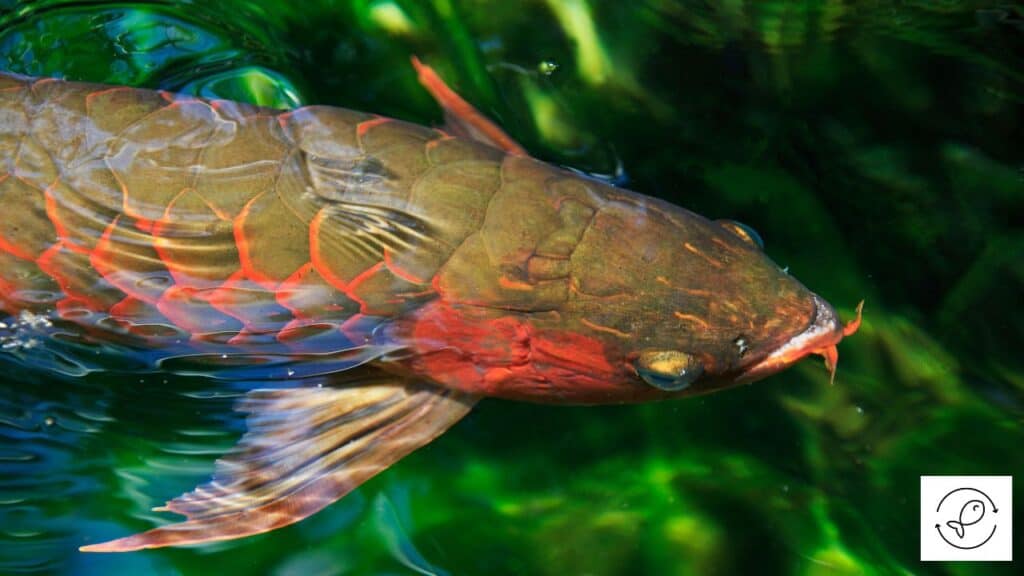Arapaimas and arowanas are freshwater fish known for their enormous size.
However, these fish are similar and unique in their own ways.
Similarities Between Arapaimas and Arowanas
You might be surprised to learn that arapaimas and arowanas have much in common.
Let’s take a closer look at the similarities between these two species.
Ancient Roots
Arapaimas and arowanas are ancient fish species that have been around for ages.
These ancient species offer valuable information about life that dates back millions of years.
Both these fish species show evidence of their abilities to evolve and adapt to changing environments.
Unique Mouth Structure
Both fish possess a unique mouth shape that helps them capture their food.
Arapaimas have a large, bony tongue, while arowanas have a unique jaw that allows them to snatch food from the water’s surface.
Surface Dwellers
Arapaimas and arowanas spend most of their time near the water’s surface.
This shared trait is due to their hunting style and the fact that they need to breathe air from time to time.
Air Breathers
Arapaimas and arowanas have the unique ability to breathe air, which is uncommon in most fish species.
They use a special organ called a swim bladder to gulp in the air and extract oxygen.
Colorful Creatures
These fish are known for their stunning colors and patterns. Arapaimas have a mix of red, green, black, and silver scales.
Arowanas also come in various colors, like silver, black, gold, and red.
Differences Between Arapaimas and Arowanas
There are some differences between arapaimas and arowanas in their behavior and living environment.
These differences make both of them unique in their own sense.
Let’s take a closer look at the differences between these two species.
Different Origins
Arapaimas call the Amazon River Basin in South America their home.
However, they were introduced to different tropical places.
In contrast, arowanas are found in the rivers and swamps of every continent except Antarctica.
Freshwater vs. Brackish Water
While both species prefer freshwater, some arowanas have adapted to live in brackish water.
Arapaimas, on the other hand, stick to strictly freshwater environments.
Enormous Size
Arapaimas and arowanas are large fish, with arapaimas reaching lengths of up to 10 feet.
Arowanas can reach up to 3 feet in length, making them quite large compared to other fish.
Both these fish species will outgrow most of the fish in the aquarium hobby.
Hunting Techniques

Arapaimas and arowanas have different hunting styles.
Arowanas are known to jump out of the water to catch insects, birds, and small mammals.
Arapaimas, however, use their bony tongue to crush prey before swallowing it whole.
Social Behavior
Arowanas are more solitary creatures, often preferring to swim alone.
On the other hand, arapaimas can be found in groups called shoals.
Parenting Styles
When it comes to raising their young, arapaimas and arowanas, have distinct approaches.
Male arowanas protect their eggs by carrying them in their mouth until they hatch.
On the other hand, arapaimas work together as a pair to guard their nest and care for their offspring.
Legal Status
Arowanas are highly sought after in the aquarium trade, leading to overfishing and habitat destruction.
As a result, some arowana species are now considered endangered.
Arapaimas also face threats from overfishing, but they aren’t as widely traded as arowanas.
Can Arapaima and Arowana Live Together?
No. It’s always best to let these giant fish live separately.
Given below are some of the reasons why arapaimas and arowanas can’t live together.
Gigantic Size
Due to their large size, arapaimas and arowanas need a large-sized aquarium for optimal growth.
Most home aquariums don’t have enough space to house one of these fish, let alone both.
Possibility of Conflict
Arapaimas are more social and can be found in groups, while arowanas prefer to keep to themselves.
So if they were placed together, the arowana might become stressed or territorial, leading to conflict with its tankmate.
Water Requirements
Even though both fish prefer freshwater, some arowana species are known to venture into brackish water.
Keeping both fish in the same tank could mean one isn’t getting the ideal water conditions to thrive.
Safety First
With their large size and powerful jaws, arapaimas and arowanas could pose a threat to each other if they were housed together.
Smaller arowanas might be seen as prey by the larger arapaima, which could lead to dangerous situations.

